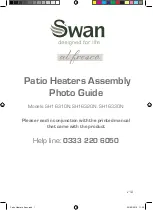
32
Servicing should only be performed by a Qualified Service Agent
Continuity test during operation
This test is performed while the Combustion Blower is running at high speed during the Pre-Purge operating
state. The test is performed on all three pressure switches. Disconnect the two wires to each pressure switch
- one at a time, check continuity and then reconnect the wires to that switch before testing the next switch.
1. Ensure power to the water heater is turned off at the water heater's on/off switch.
2. Ensure the sensing tubes from each pressure switch are connected to the correct sensing port on the
water heater, see Sensing Tubes on page 30.
3. Disconnect the two wires for the switch to be tested.
4. When testing the Blocked Exhaust and Blocked Intake Air switches, connect a small jumper wire to the
short the two wires disconnected. This will temporarily prevent the Control System from locking out during
the test. When the test for these two switches is complete, remove the jumper wire and reconnect the
pressure switch wiring before moving on to the next switch.
5. Restore power to the water heater, if the water heater does not begin a heating cycle raise the Operating
Set Point to activate a heating cycle.
6. Using an ohm meter set for continuity testing, check for continuity between the two wiring terminals at the
pressure switch after the Combustion Blower has started and ramped up to high speed during the Pre-
Purge operating state, see figure 33 on page 31. Record the results; open or closed.
7. Repeat this procedure for each pressure switch.
8. Ensure the wires to all pressure switches are reconnected when testing is complete.
Results/Actions
Passed Results:
If the Blower Prover switch contacts activate/close (zero ohms/direct short) during this test
the switch has passed this test. If the Blocked Intake Air and Blocked Exhaust switch contacts remain closed
during this test, (zero ohms/direct short), these switches have passed the test.
Failed Results:
If the Blower Prover switch contacts do not close during this test, the Pressure Test During
Operation below must be performed to determine if the switch is defective. If the Blocked Intake Air or
Blocked Exhaust switch contacts open during this test, the Pressure Test During Operation below must be
performed to determine if the switch(s) is defective.
Proceed to the Pressure Test During Operation below.
pressure test during operation
This test will be performed while the Combustion Blower is running at high speed during the Pre-Purge
operating state. This test is necessary when a pressure switch has passed the Continuity Test During Standby
on page 31 but has failed the Continuity Test During Operation above to determine if the pressure switch is
defective or not. This test requires a digital manometer, see Tools Required on page 2.
Service Notes:
•
Before performing this test examine the sensing tube connections on the water heater’s sensing ports
and on the pressure switch. Check for wear, cracks, leaks, kinks, or any kind of debris or condensate in
the sensing tubes, repair/replace as necessary.
• To determine if a pressure switch is operating properly you must first know the "switch action" (whether
the switch activates on a rise or a fall in pressure) and the "activation pressure" the switch will activate
at. Activation pressures are provided in Table 3 on page 33. Switch actions are as follows:
•
Blower Prover switch - normally open contacts, close on a rise in pressure.
•
Blocked Intake Air switch - normally closed contacts, open on a fall in pressure.
•
Blocked Exhaust switch - normally closed contacts, open on a rise in pressure.
Activation Pressures
Table 3 on page 33 shows the activation pressures and tolerance for each of the three pressure switches. A
+ sign before the pressure indicates a positive pressure; above atmospheric pressure. A - sign before the
pressure indicates a negative pressure (in a vacuum); below atmospheric pressure. Tolerances are specified
to allow reasonable leeway for imperfections and inherent variability without compromising performance.
















































